Actually there are 2 questions, one is more advanced than the other.
Q1: I am looking for a method that similar to corrplot() but can deal with factors.
I originally tried to use chisq.test() then calculate the p-value and Cramer's V as correlation, but there too many columns to figure out.
So could anyone tell me if there is a quick way to create a "corrplot" that each cell contains the value of Cramer's V, while the colour is rendered by p-value. Or any other kind of similar plot.
Regarding Cramer's V, let's say tbl is a 2-dimensional factor data frame.
chi2 <- chisq.test(tbl, correct=F)
Cramer_V <- sqrt(chi2$/nrow(tbl))
I prepared a test data frame with factors:
df <- data.frame(
group = c('A', 'A', 'A', 'A', 'A', 'B', 'C'),
student = c('01', '01', '01', '02', '02', '01', '02'),
exam_pass = c('Y', 'N', 'Y', 'N', 'Y', 'Y', 'N'),
subject = c('Math', 'Science', 'Japanese', 'Math', 'Science', 'Japanese', 'Math')
)
Q2: Then I would like to compute a correlation/association matrix on a mixed-types dataframe e.g.:
df <- data.frame(
group = c('A', 'A', 'A', 'A', 'A', 'B', 'C'),
student = c('01', '01', '01', '02', '02', '01', '02'),
exam_pass = c('Y', 'N', 'Y', 'N', 'Y', 'Y', 'N'),
subject = c('Math', 'Science', 'Japanese', 'Math', 'Science', 'Japanese', 'Math')
)
df$group <- factor(df$group, levels = c('A', 'B', 'C'), ordered = T)
df$student <- as.integer(df$student)



